
In the Shadow of Vienna
Lieutenant-General Jonathon Riley - 2014
The Treaty of Ghent and the End of the War of 1812, June to December 1814
Four months after the fall of Napoleon, as plans were being agreed for a great peace congress to be held in Vienna in September, three British and five American negotiators met in the small town of Ghent in the newly-independent nation of Belgium. Their task was to frame a treaty that would end the war that had begun with James Madison’s declaration on 18 June 1812 – a war which almost no-one in Britain and many in the United States had never wanted. A war that was as much as anything the result of strategic miscalculations on both sides and in which neither side could be said to have achieved a decisive result.
For Britain, the American war had never been anything but a side-show in the titanic struggle against Napoleon: a struggle from which only one side would emerge intact and which had been concluded only when all the powers of Europe, united in one coalition financed by the commercial wealth of Britain, finally broke him. And now the conclusion of the war was hardly being treated as top of the agenda and the result seemed of little importance when compared with the issues at stake in Europe – provided that the British red lines could be held: the security of British North America, the navigation of the St Lawrence and the Great Lakes and the protection of Britain’s native allies.

James Gambier and Henry Goulourn
The three negotiators were Vice-Admiral James Gambier; Henry Goulburn the Undersecretary for War and Colonies; and William Adams, an expert in maritime and naval law. Gambier had been Governor of Newfoundland and had commanded the naval forces at the bombardment of Copenhagen in 1807. Before going to Ghent had served a long stretch with the Channel Fleet – during which time he faced a court-martial where he was exonerated from charges of having failed to advance and bring a French squadron to battle. He was therefore an experienced naval officer who had held high command and who knew the maritime issues that had helped to bring on the American war; but he was hardly an experienced negotiator or diplomat and not even a full admiral. Henry Goulburn was a young man, a Tory MP, only thirty years old, who had held middle-ranking posts in Government since 1808. He had relatively little experience in diplomacy and foreign affairs and had never undertaken military service. He was however expected to lead the negotiations, was trusted to be firm in maintaining British interests and, because he was relatively junior, maintain close communication with government. William Adams, a clever lawyer in his early forties was again inexperienced in foreign, diplomatic and military affairs. Only Gambier had any first hand knowledge of North America and its situation. Very limited secretarial support was provided and the commissioners were given almost no leeway in their negotiating powers – given that they were only four days’ journey from London. Strangely, no-one from British North America was included in the delegation.
Compare this with the delegation that was being prepared for Vienna: the Foreign Secretary himself, the great Lord Castlereagh; Lord Cathcart, the British Ambassador to the Court of St Petersburg and British Commissioner with the Russian Armies since 1812; Lord Clancarty had been President of the Board of Trade and Ambassador in the Netherlands, where he had gained the respect of Talleyrand; and Sir Charles Stewart, Castlereagh’s half brother and an experienced soldier (whom nevertheless, the Congress refused to take at all seriously). As well as the delegates there was a strong supporting cast: the Undersecretary of State for Foreign Affairs with a team of eleven assistants under Castlereagh’s private secretary; and a cohort of King’s messengers.
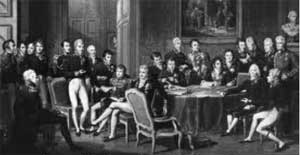
The British Delegation at Vienna
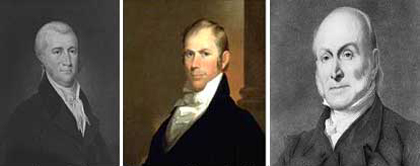
John Quincy Adams, Albert Gallatin and Henry Clay
Being still in the middle of a hot war, neither side trusted the other. The British believed that the Americans were not sincere and were attempting to gain by diplomacy, what they had failed to gain by war. On the American side there was the belief that Britain wanted to dismember the United States and take back as much territory as she could. Both believed themselves to be the injured party. Nor was there even an understanding about how the negotiation would be conducted, since there was no obvious winner at this stage and no chance even of an armistice – since both sides saw the continuation of the war as the means of influencing the outcome of any treaty.
All that said, both sides wanted an end to a war that might otherwise drag on for years. Lord Castlereagh in a letter to the British Commissioners urged them 'to assure the American commissioners that the British Government, whatever sense it may entertain of the causes of the rupture, is sincerely desirous of a permanent adjustment of all differences, and that this desire is not abated by the successful termination of the war in Europe; and that, with this view, you are authorised to meet with frankness and conciliation whatever propositions the American negotiators may be prepared to offer, for terminating the war which has been declared by their government.' This was generous because the prospects for holding the Canadas and expanding the war onto American territory were as bright as they had ever been – On 31 March, the allies marched into Paris. Six days later Napoleon abdicated and Britain was free to unleash its full military power against the United States: the Royal Navy, with more than 1,000 ships in commission and Wellington, who had received instructions in April to prepare 13,000 Peninsular veterans for redeployment to North America. In contrast to Castlereagh’s conciliatory tone, Lord Bathurst had told Governor-General Prevost that ‘it is the wish of His Majesty’s Government to press on with the war with all possible vigour up to the moment when Peace shall finally be concluded.’
The American position was harder. Madison and James Monroe believed that the British must accept certain conditions - after all, America had declared war and to come away with no advantage would spell political ruin for both men and for their party, as well as dishonour for the nation. While the US might not be able to win a battlefield victory, it might still – as the British believed was the game – gain a diplomatic victory. If British North America could not be annexed to the United States, at the very least an unhindered westward expansion should be agreed. Monroe’s instructions to the American commissioners were therefore somewhat different in tone from Castlereagh’s: ‘If Great Britain does not terminate the war on the conditions you are authorized to adopt,’ he said, then the war would go on. This was optimistic indeed because of the American situation; the Treasury was essentially bankrupt, the result of the costs of the war itself and the stranglehold of blockade. The Royal Navy took 1,400 American ships and 20,000 seamen between 1812 and 1815, effectively stopping all American trade except for that needed and permitted by England; in spite of the early ship-to-ship victories by the US Navy, the Royal Navy soon established complete supremacy at sea and was never seriously threatened by its smaller rival. US GDP rose dramatically between 1803 and 1814, from $0.5 billion to $1.1 billion, reflecting the fortunes being made from illicit wartime trade in collusion with the British – it fell back rapidly once peace was signed; however government revenues never rose above $20 million a year and the burden of paying for the war was therefore insupportable. Worse, Congress had refused to allocate sufficient funds for the war which could only come through borrowing and the Treasury was limping from one crisis to the next, never knowing for sure where money was coming from. The US Army faced a manpower crisis as terms of enlistment ran out; the invasion plans of 1813 had all failed although one result was that there was an infusion of new and younger blood into the senior ranks.

The Royal Navy's blockade of the USA,
from Carl Benn's The War of 1812
In Ghent, both Gallatin and Bayard were seriously alarmed at the thought that, rather than being war weary, the British people were clamouring for the punishment of the US: ‘They do not even suspect that we had any just cause for war,’ wrote Gallatin, ‘and ascribe it solely to a premeditated concert with Bonaparte at a time when we thought him triumphant and their cause desperate.’ Bayard also warned that continued war with America would be used as a pretext to keep a larger peacetime military establishment in Britain than was usually allowed by parliament. Clay, however, was determined not to compromise.
Negotiations finally opened in Ghent on 8 August 1814, by which time the British had re-established supremacy on Lake Ontario, secured their hold on Maine and opened operations in the Chesapeake. The issues at this time, on which any treaty would be determined, were essentially four:
-
First, Maritime Rights. For the British this meant essentially the right to recapture deserters; for the Americans it meant an end to searching of ships and the impressment of US citizens – including deserters from the Royal navy who had taken US citizenship. As this was likely to be a highly contentious issue, Castlereagh instructed the British delegation to refer any decision to him.
-
Secondly, Native American Rights. For the British this meant protection for the native people as the allies of King George, preferably by the establishment of an area of territory permanently ceded to the Indian nations which would act as a buffer between the US and British North America; the Americans however could not view the native people as if they were a nation, equal in status, with whom treaties could be made and were appalled at the idea that the British sought to carve out territory for them – as Bayard wrote, ‘to alter the condition of the Indians in relation to the United States?’
-
Thirdly, the regulation of the frontier and the removal of future causes of conflict. US seizure of parts of the Floridas from Spain made Castlereagh very suspicious of their intentions and determined to resolve the outstanding ambiguities of the 1783 treaty. Ideally, the British meant to hold on to the frontier forts they had taken and advance the border of Lower Canada southwards – by these measures communication along the St Lawrence and through the Lakes would be assured.
-
Last, fishery: under the treaty of Paris, the Americans were allowed to fish within British territorial waters which they were anxious to preserve but the British saw no reason to reward their treachery with this privilege.
The early meetings brought almost no meeting of minds, especially as the Americans claimed to have no instructions on the matters of the native people and the fishery. Adams summed up the general feeling that ‘I do not think that the negotiation will be of long continuance.’ The British however also needed to refer the Americans inability to discuss the native question, and negotiations were almost immediately suspended.
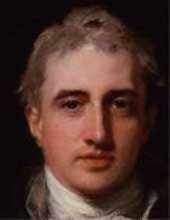
Lord Castlereagh
On 19 August, negotiations were reopened with the arrival of an unexpected addition to the British team: none other than Lord Castlereagh himself, en route for Vienna with his full retinue and his mind filled with the matter of redrawing the map of Europe. Castlereagh found it impossible to believe that the American delegation had no clear instructions on the matter of the native people and the fishery. He agreed with Goulburn that the future of the negotiation hung on the issue of ‘whether the Commissioners will or will not take upon themselves to sign a Provisional Agreement upon the points on which they have no instructions. If they decline this, the British Government sees no advantage in prosecuting the discussion further. . .’ The position on natives was not at this stage open to compromise.
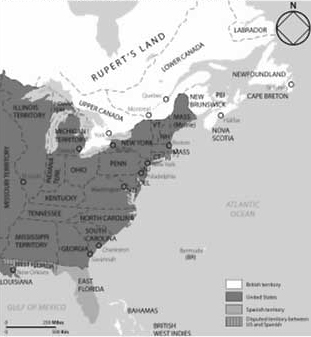
British North America and The United States 1800-1812
He did however offer some clarification, indeed softening, of the position on the border: this was to be ‘strictly defensive’ (a phrase employed in relation to British North America since at least 1805). The Lakes were to form the bulk of the frontier, which British North America, as the party least capable of resisting invasion in a timely manner, was most entitled to claim. Military control of the barrier and the shores, must on that basis, go to Britain. However if Britain insisted on such a position, she would gain territory from the Americans and this was not the objective. Therefore the compromise was that military bases on the southern shore should be dismantled and traffic on the lakes restricted to commercial use only. However the southern border of Lower Canada would move to ensure communication between Halifax and Quebec; the British also wanted free navigation of the Mississippi and therefore the border between Lake Superior and the headwaters of the river would also have to be adjusted as well as insisting on the inclusion of Passamaquody Bay in the Province of Nova Scotia. On the question of the native people, Castlereagh was clear that they were to be included in any treaty, however to Goulburn’s fury, he was not prepared to guarantee the native people against future wars of conquest or territorial purchase by America.
The new instructions did little to mollify feeling in the American delegation and Clay in particular had no intention of even presenting these proposals to his government. In the meantime, Washington was taken and sacked, but Baltimore was saved and in September the British campaign on Lake Champlain ended in withdrawal. But this news took some time to reach Europe and while it did the Americans, faced with a British position that clearly said “treat now or face tougher terms later”, worked on a response which they expected to bring a rapid end to the negotiations. The note insisted that the war had its origins wholly in maritime issues; that the surrender of territory to the native people was unacceptable; and that unilateral demilitarisation of the Lakes could not be contemplated – both were new issues not connected with the start of the war (the fact that they had initiated offensive operations on land and must therefore accept the consequences was conveniently overlooked). Their position was that all territory should be restored to its original owners and rights in regard of their seamen should likewise rest with each belligerent nation. Finally that ‘all issues over which either nation felt differences or uncertainty had existed’ could be discussed – but that a treaty should not depend on these issues.
Goulburn concluded that this view needed to be communicated to the British cabinet; the American position startled both Lord Liverpool and Lord Bathurst. Liverpool felt that if negotiations were broken off on the basis of the exchange of notes thus far, public opinion in America might well swing in favour of further fighting. He therefore proposed a more conciliatory tone, but also to continue fighting in the expectation of success in the field. Goulburn and Adams however were permitted to make changes to the style and tone of the cabinet’s reply so that when it was presented, it appeared a great deal tougher than had perhaps been intended – detailing American aggression in the Canadas as well as against Spanish Florida. There was also a vigorous defence of the native question and the status of the people.
The response from the American side was predictable and produced nothing new. However separately, both Lord Liverpool and Castlereagh had begun to have second thoughts. Faced with the great questions of a European settlement, the American treaty seemed of increasingly small importance. In parallel, the order to prepare 13,000 Peninsular veterans for service in North America was reduced to only 2,600 who would reinforce the 3,400 under Major-General Robert Ross; and Liverpool succumbed to admiralty pressure to postpone any operation against New Orleans until December – a fatal error that allowed the Americans to garrison a city into which the British could have marched unopposed in September. The British government also was moving away from its demands on guarantees for the native people and unilateral disarmament of the Lakes. A note to this effect was delivered to the Americans on 20 September and although the essential points were buried in the small print of a long document, it was quickly recognised for what it was: a major shift in position.
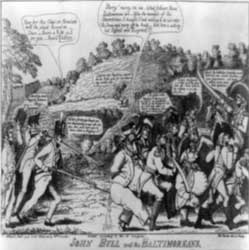 While both sides continued to manoeuvre, news of the burning of Washington came in, which threw the American delegation into alarm: ‘this is,’ wrote Gallatin, ‘only the beginning of our sorrows.’ However the British made no move to exploit the position. Instead, on October 5, a new British proposal made no mention of creating a separate native nation but insisted instead that both countries end all hostilities with the Indians and restore all privileges and rights enjoyed by them before 1811, provided that they too agreed to end all hostilities. If this was not acceptable then the negotiations would be terminated.
While both sides continued to manoeuvre, news of the burning of Washington came in, which threw the American delegation into alarm: ‘this is,’ wrote Gallatin, ‘only the beginning of our sorrows.’ However the British made no move to exploit the position. Instead, on October 5, a new British proposal made no mention of creating a separate native nation but insisted instead that both countries end all hostilities with the Indians and restore all privileges and rights enjoyed by them before 1811, provided that they too agreed to end all hostilities. If this was not acceptable then the negotiations would be terminated.
The Americans argued among themselves for four days and as they did, the early reports of the Plattsburgh expedition, Passamaquody Bay being taken, the frigate Adams burned and British successes on Lake Huron and in the northern Mississippi territory came in. The Americans accepted the British proposal concerning the native people but requested that the British provide a treaty ‘embracing ALL the points deemed material by Great Britain’, to which they would then present a ‘counter-projet with respects to all the articles…deemed material by the United States.’ What they did not know was that back in the US, Secretary Monroe had despatched instructions to them to drop all demands, if it were possible only to restore the status quo ante bellum. But by mid-October, the failures at Baltimore and Prevost’s failure at Plattsburgh, with the news of the death of Ross, all came in. Liverpool regretted sending most of the available reinforcements to the Canadas rather than to Ross but it was too late to cry over spilt milk.
For the next two weeks the commissioners exchanged terse notes which inched things towards the next step: who would table a draft treaty. On 31 October, the British made a move which proved decisive. If the article concerning the native people was accepted, everything that Britain wished to achieve had been set out in earlier notes, and therefore the Americans must come forward now with a draft treaty. In doing so they were mindful of the position of Lord Wellington when asked if he would go to America and take the command
In spite of a lack of detailed knowledge, books or maps, Wellington wrote one of the most telling appreciations of the situation in the Canadas which has ever appeared:
'Any offensive operation founded upon Canada must be preceded by the establishment of a naval superiority on the Lakes . . . the defence of Canada and the co-operation of the Indians depends on the navigation of the Lakes. . .’'
Then in direct answer to the question, he wrote that
'In such countries as Canada, very extensive, thinly peopled, and producing but little food in proportion to their extent, military operations are impracticable without river or land transport. Coastal amphibious operations are liable to the same objections, though to a greater degree, than an operation founded in Canada. I do not know where you could carry on such an operation which would be so injurious to the Americans as to force them to sue for peace.'
So with no identifiable centre of gravity, the American war was unwinnable by either side; there was nothing to be gained from further fighting, that a decisive act was all but impossible and a settlement might as well be signed now as later. The framing of this fell to Gallatin and John Quincy Adams and the first attempt was far too ambitious – even though the mood in London was now, if truth be told, for peace at almost any price. Wellington’s harsh analysis had rattled Liverpool and from Vienna, Castlereagh warned that the American war was weakening Britain’s military position, although no other European power was likely to assist America. Worse, Bonapartist elements in France threatened further instability, even war, and it made no sense to shift Wellington and a large part of the available British army across the Atlantic. Negotiations in Ghent passed to and fro and all was nearly lost on the almost peripheral issues of the fishery and the possession of Moose Island: both of interest only to the people of Maine. But at last, on Christmas Eve, agreement was reached. It was, wrote Gallatin, ‘as favourable as could be expected under existing circumstances, so far as they are known to us’. Clay wrote that ‘the conditions of the peace certainly reflect no dishonour on us.’ In this way the man who had urged America to war glibly explained away her failure to achieve none of the war’s goals, the ruin of the exchequer, the desolation of the Niagara frontier, the occupation of her territory and a significant loss of life. Honour had been preserved and that was enough.

The conclusion of the Anglo-American
Treaty of Ghent
What did the treaty say? The initial articles described ratification, exchange of prisoners, and the restoration of archives and records. Both parties would work to abolish the slave trade. The international boundary agreed in 1783 was to be the basis of a commission which would settle it in the coming years and five lengthy articles described the detail of this.
The question of demilitarisation of the Lakes was bound up with these articles. Both parties would work to abolish the slave trade. The native question was parked in the terms suggested by the British. This spelled the end of their influence on the balance of power in North America; in the aftermath of the war, US westward expansion accelerated and the native nations that stood in its way either fled in front of it, or were confined to reservations, or were slaughtered. If anyone lost the war of 1812, it was they.
The treaty was ratified quickly in Britain but not ratified in Washington until after the news of New Orleans was received in early February. The response to the treaty in the United States was generally favourable: nothing much had been lost and no penalty for aggression had been incurred. The victory at New Orleans, pointless though the battle was, captured the popular imagination far more: it was after all the nearest thing to a decisive victory that American arms could claim in nearly three years.
In Britain, reaction to the treaty was largely negative for although peace was desired, British North America had not been secured against future attack, the native people had not been supported and this could only harm the valuable fur trade – even though agriculture and forestry were already surpassing it in importance. Lord Liverpool and the Commissioners all came in for criticism: The Times called it ‘a premature and inglorious peace’ which allowed America to escape its just punishment, but rage was short-lived for no-one had really ever wanted war in the first place. Further scrutiny was curtailed by Napoleon dramatic reappearance on 1 March and more than a few wondered just how things might have stood, had Britain sent most of its regular force across the Atlantic.
In the Canadas, the peace was received better – for was British North America not still part of the Empire? The war had had a unifying effect on colonists of very different origins and the myth that it was the militia that had saved the nation, rather than the truth – that it had been British and Colonial regular troops – took a very long time to dispel.
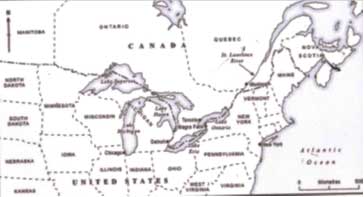 The issues left open for resolution by the treaty took years to finalise – the final dispute between Nova Scotia and Maine was not settled until 1894. In late 1815 the British withdrew from the forts they held on the Mississippi and from Mackinac, on Lake Huron. In 1816 Congress barred cross-border trade with the native people, In 1817 the Passamaquoddy islands were divided. The British gave up any claims on the Mississippi and commercial agreements, including fishery, were largely reinstated in their pre-war forms. Future potential military confrontation on the lakes was de-fused by the Rush-Bagot agreement in 1817 strictly limited naval activity and in 1818, the 49th parallel from Lake of the Woods to Stony Mountain was agreed as the border, with the area west of that shared until 1828 when a new border commission would determine it.
The issues left open for resolution by the treaty took years to finalise – the final dispute between Nova Scotia and Maine was not settled until 1894. In late 1815 the British withdrew from the forts they held on the Mississippi and from Mackinac, on Lake Huron. In 1816 Congress barred cross-border trade with the native people, In 1817 the Passamaquoddy islands were divided. The British gave up any claims on the Mississippi and commercial agreements, including fishery, were largely reinstated in their pre-war forms. Future potential military confrontation on the lakes was de-fused by the Rush-Bagot agreement in 1817 strictly limited naval activity and in 1818, the 49th parallel from Lake of the Woods to Stony Mountain was agreed as the border, with the area west of that shared until 1828 when a new border commission would determine it.
What of the Commissioners? On the British side, Gambier rose by seniority to Admiral of the Fleet just before his death in 1830. William Adams took part in the moves to dissolve the marriage of George IV and Queen Caroline but retired on grounds of ill health in 182. He lived on until 1851. Goulburn’s career was long and distinguished – an uncompromising conservative, he was Chancellor of the Exchequer twice and Home Secretary in succeeding Tory governments. He died in 1856.
On the American side, John Quincy Adams and Henry Clay both ran for President in 1824; at the same time Gallatin was the running mate of William Crawford. Adams eventually won the race and Clay, who supported him in the final run-off against Jackson, became Secretary of State. Adams survived only one term before being beaten by Jackson. He returned to Congress where he served until his death in 1848. Clay remained in opposition until his death in 1852. Bayard was taken ill with a severe chest infection before leaving Europe at the close of the negotiations; he died five days after his return to the US. Gallatin, the man who had perhaps done most to nudge the American delegation step by step towards a treaty, continued his diplomatic career and in later life studied the native people of North America. He founded the American Ethnological Society in 1842. Finally Jonthan Russell launched a furious smear campaign against his fellow commissioners which ended in his disgrace in 1822. He died ten years later, as Adams wrote, ‘sufficiently punished in this world for his perfidy’.
Ultimately, the best one can say of the Peace of Ghent is that even though most people in Britain and in British North America did not recognise it at the time, it preserved BNA by establishing a secure frontier. This, along with the sense of emerging nationhood that the war had brought, accelerated the movement that led in only 50 years to the arrival of Canada as a country.
Copyright Notice: Unless explicitly stated otherwise, all rights including those in copyright of the documents and content of this website are owned by or controlled for these purposes by Jonathon Riley (Generalship Ltd). Except as otherwise expressly permitted under copyright law or Generalship Ltd's Terms of Use, the aforementioned content may not be copied, reproduced, republished, downloaded, posted, broadcast or transmitted in any way without first obtaining written permission of the copyright owner.